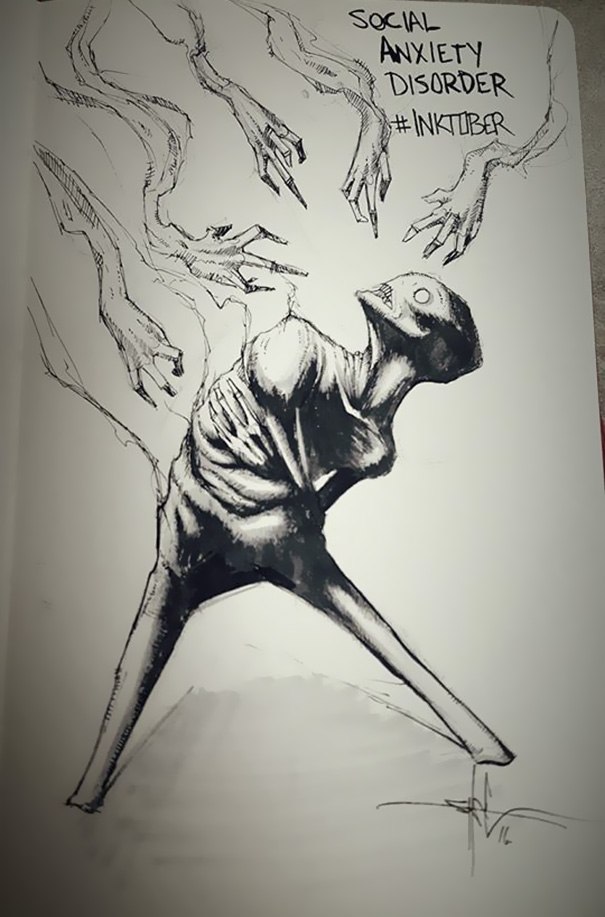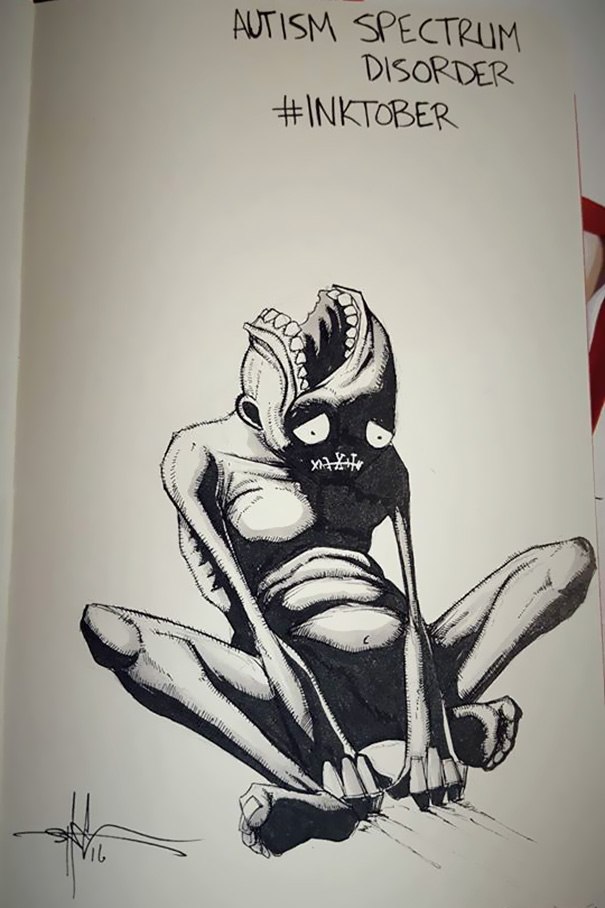As dark as they seem, apart from shocking the viewers and drawing their attention to the severity and commonness of mental disorders, the illustrations, serve as means to address some misconceptions about mental illness and disorders. Also, the understanding shown in the illustrations, hopefully, can help many sufferers from any of the portrayed illness or disorder to feel less alone in their struggle and urge the public to help the ones in need.
1. Major depressive disorder
Depression is too often misunderstood as personal weakness manifested by a person feeling sad and unwilling to change. A depressive disorder has nothing to do with personal strength, but it can happen to anyone experiencing the trauma of any type of loss, whether it be of a loved one, or a job. Likewise, sadness is not the only indicator of this disorder, as a person suffering from it undergoes many physical and emotional symptoms that last for a longer period of time.
2. Social anxiety
Social anxiety is a very common mental disorder usually misinterpreted as fear of public speaking and shyness. While people suffering from social anxiety do fear speaking in front of a large crowd, the social anxiety makes any everyday activity (such as eating in front of others or meeting new people) more difficult for the sufferer. Social anxiety is most often mistaken for shyness. Yet, most people suffering from this disorder don’t show any signs of shyness or any other visible symptoms.
3. OCD
Most people regard OCD sufferers as neat freaks that are obsessed with cleaning. While in many cases of the disorder, a person is fixated on keeping things clean, it can manifest in many other repetitive routines. With the right treatment, including behavioral therapy, and in some cases, medication, the disorder can be successfully controlled.
4. Anorexia nervosa
Commonly mistaken for a conscious choice made in order to look good, anorexia nervosa is a serious mental issue that affects mostly female population. The disorder is triggered by person’s inability to cope with certain issues or traumas, or with an enormous amount of stress concerning their body image.
5. Bipolar disorder
It is a very common misconception to consider a bipolar disorder as mood swings that can only be treated with medication and psychotherapy. People suffering from bipolar disorder undergo severe, long-lasting mood swings that are much more extreme than those a healthy person would undergo in response to certain positive or negative events. Yet, along with the medication and therapy, a sufferer could significantly improve their condition by making positive lifestyle choices that could affect their general well-being and make the initial symptoms much easier recognized and controlled.
6. Autism spectrum disorder
The most common misconception about people suffering from this disorder is that they are unable to function socially and express their thoughts verbally. Although their social and language skills can be weakened in most cases, depending on the type of the disorder, autism spectrum disorder patients can actually be highly-functional and have high IQs, which can result in them leading perfectly successful and functional lives with the right support and treatment.
7. Schizophrenia
Wrong preconceptions about schizophrenia make people fear the patients and regard them as paranoid and aggressive. In most cases, schizophrenia patients are much more withdrawn and prefer to be alone. Delusions and inability to process emotions and make decisions are other symptoms that are experienced by people suffering from this disorder.
8. Agoraphobia
People suffering from agoraphobia are usually falsely considered as loners who never leave their home. In most cases, it is the exactly the outside where they seek relief, usually the less crowded places in nature. Agoraphobia sufferers have completely healthy social lives that include going to events and trips with their friends that make them feel comfortable and safe.
9. Insomnia
Contrary to the popular belief, insomnia isn’t simply caused by taking too much caffeine or being restless. More often than not, it is related to a more serious mental condition such as anxiety and depression, and it should be treated as such.
10. Post-traumatic stress disorder
Too often PTSD is connected to the personal weakness of the sufferer, whereas, the reality is quite the opposite. The sufferer needs to be supported to express the suppressed emotions and overcome them throughout the adequate treatment and the support of loved ones. Featured photo credit: www.boredpanda.com via boredpanda.com









